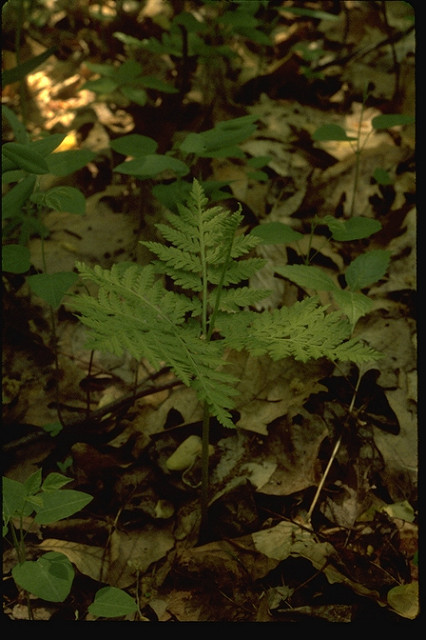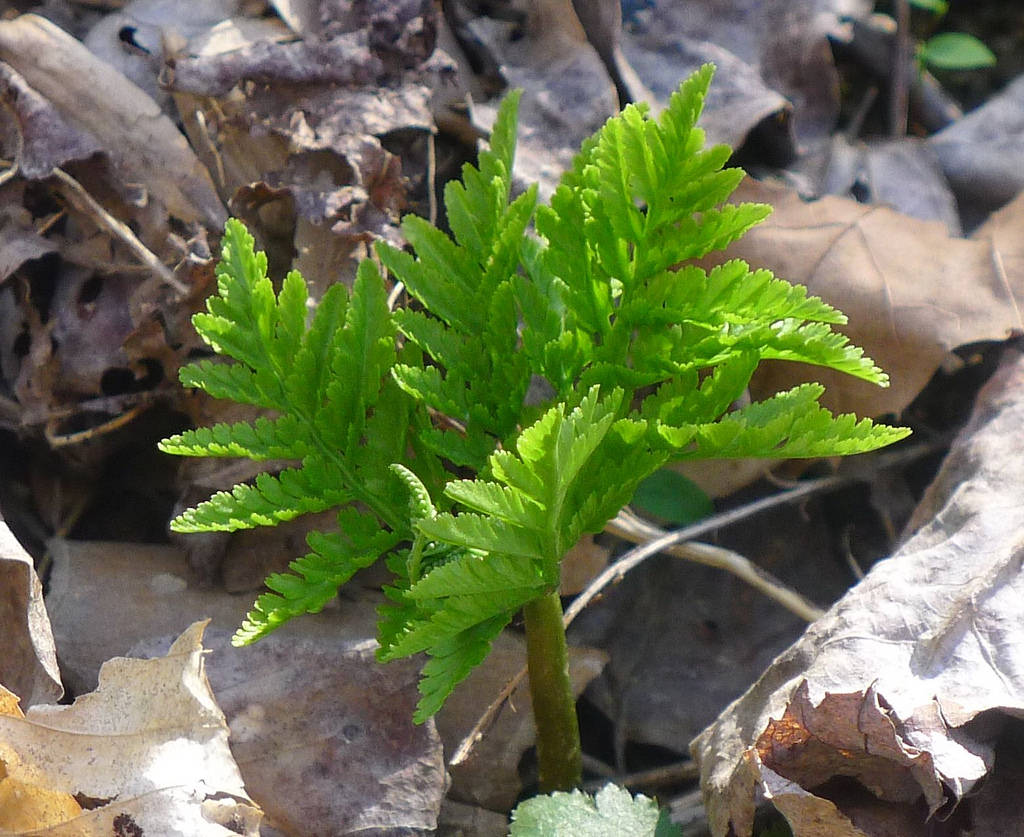Map Snapshot

























710 Records
Description
Similar to Cutleaf Grapefern which has the fertile stalk diverge from the sterile leaf blade close to the ground. The fertile stalk of Rattlesnake Fern diverges at the base of the sterile leaf blade.
Seasonality Snapshot
Source: Wikipedia
| Botrypus | |
|---|---|

| |
| Scientific classification | |
| Kingdom: | Plantae |
| Clade: | Tracheophytes |
| Division: | Polypodiophyta |
| Class: | Polypodiopsida |
| Order: | Ophioglossales |
| Family: | Ophioglossaceae |
| Subfamily: | Botrychioideae |
| Genus: | Botrypus Michx. |
| Species: | B. virginianus
|
| Binomial name | |
| Botrypus virginianus | |
| Synonyms[citation needed] | |
| |
Botrypus virginianus, synonym Botrychium virginianum, sometimes called rattlesnake fern is a species of perennial fern in the adders-tongue family.[2] It is monotypic within the genus Botrypus, meaning that it is the only species within the genus. It is called the rattlesnake fern in some parts of North America, due to its habit of growing in places where rattlesnakes are also found.[3][4] Rattlesnake fern prefers to grow in rich, moist woods in dense shade and will not tolerate direct sunlight.
Description
[edit]It is a low growing species, typically being a foot high or smaller. The leaf emerges in the early spring and will senesce in late summer. The leaf is roughly triangularly shaped and 15–50 cm in size and held roughly parallel to the ground. The leaf is 3-4 times pinnately compound, brightly green colored, and feels soft to the touch. The stem is round and bicolor, being pinkish or light tan at the base but greenish nearer the branches or leaves. The diploid number is 184.[5]
Rattlesnake fern has separate fertile and sterile leaves, when present the sterile leaf arises halfway up the stalk and the fertile leaf exists at the tip. The spores are shed in late spring. Like other ferns rattlesnake fern undergoes alternation of generations and the form described in this article is the sporophyte.
This fern has been used medicinally. In India it is still used to treat dysentery.[6]
Taxonomy and genetics
[edit]
Recent[when?] research has determined that the mitochondria are genetic chimera. DNA from some member of the Santalales, possibly a species of mistletoe, has transferred to the mitochondrial genome of this species of fern.[7] It is believed that this transfer may have helped to enable this plant's cosmopolitan global distribution.
This plant has traditionally been included in the genus Botrychium as the subgenus Osmundopteris (based on the species' superficial similarities to the genus Osmunda[8]), but was unique within the genus because of chromosome number and other signatures, including the inclusion of presumed mistletoe DNA within its mitochondria. Recent[when?] research has established that this plant is sister to all other botrychioid plants, including both the genus Botrychium sensu stricto – rattlesnake fern,[9] common grapefern[10] – and the genus Sceptridium, with the exception of a single known species, previously included in Botrypus, which is B. strictus. That plant was shown to be sister to all other botrychioids, so must be segregated in its own genus.[11]
Distribution
[edit]This is a wide-ranging species. It abounds in many parts of the United States, in the mountains of Mexico, in Australia, in some parts of Asia, as the Himalaya Mountains, and is found also in Norway, in the Karelia region of Finland and Russia, and around Gulf of Bothnia, although in no other part of Europe. It is large and succulent and is boiled and eaten in the Himalayas.
References
[edit]- ^ "NatureServe Explorer 2.0 - Botrychium virginianum Rattlesnake Fern". explorer.natureserve.org. Retrieved 9 October 2020.
- ^ Christenhusz, Maarten J. M.; Zhang, Xian-Chun; Schneider, Harald (2011). "A linear sequence of extant families and genera of lycophytes and ferns" (PDF). Phytotaxa. 19: 7–54. doi:10.11646/phytotaxa.19.1.2.
- ^ NRCS. "Botrychium virginianum". PLANTS Database. United States Department of Agriculture (USDA). Retrieved 17 Jan 2011.
- ^ Rhoads, Ann; Block, Timothy (5 September 2007). The Plants of Pennsylvania (2 ed.). Philadelphia Pa: University of Pennsylvania press. ISBN 978-0-8122-4003-0.
- ^ "Botrychium virginianum". www.efloras.org. Retrieved 17 June 2016.
- ^ Ethnobotanical Leaflets Archived 2012-03-16 at the Wayback Machine
- ^ Davis, C. C., et al. 2005. Gene transfer from a parasitic flowering plant to a fern. Archived 2008-09-08 at the Wayback Machine Proc. R. Soc. B 272, 2237–2242.
- ^ Cobb, Farsworth & Lowe, Ferns of Northeastern North America 2nd edition, p. 247 (2005)
- ^ NRCS. "B. virginianum". PLANTS Database. United States Department of Agriculture (USDA). Retrieved 27 Dec 2011.
- ^ B. virginianum Flora of North America, www.eFloras.org 26 Dec 2011
- ^ Hauk, Warren D.; Parks, Clifford R.; Chase, Mark W. (2003). "Phylogenetic studies of Ophioglossaceae: evidence from rbcL and trnL-F plastid DNA sequences and morphology". Molecular Phylogenetics and Evolution. 28 (1): 131–151. Bibcode:2003MolPE..28..131H. doi:10.1016/S1055-7903(03)00032-0. ISSN 1055-7903. PMID 12801476.





















